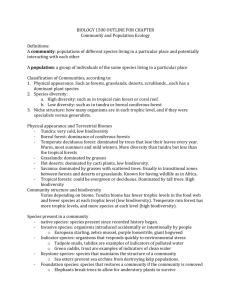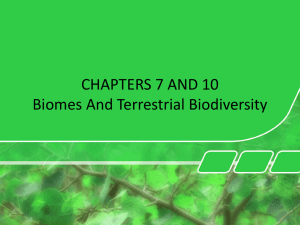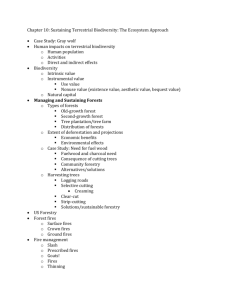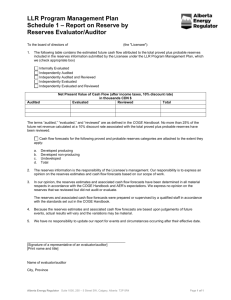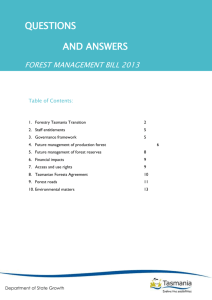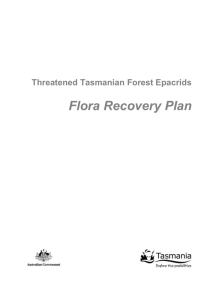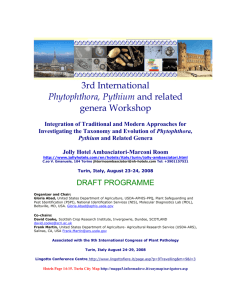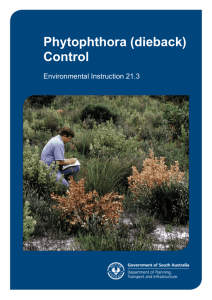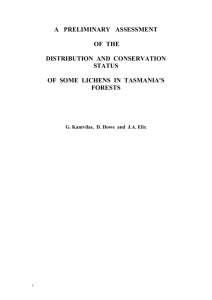Biodiversity Fund Investing in Tasmania*s Native Forests 2013
advertisement
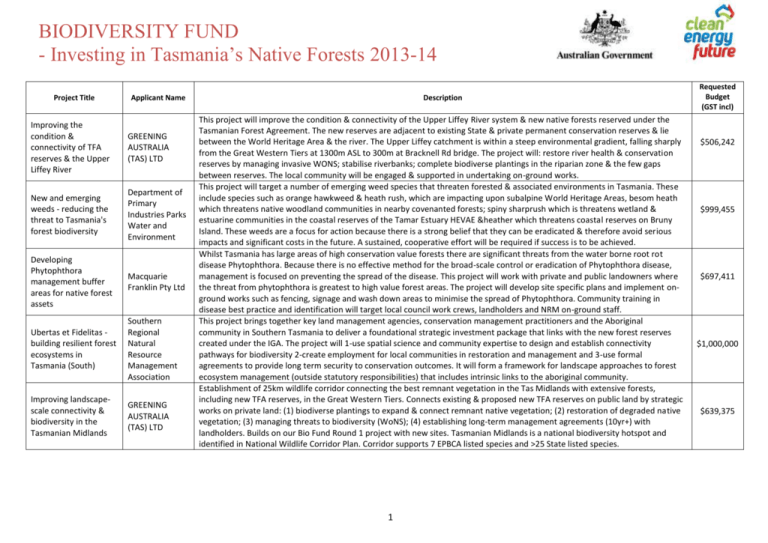
BIODIVERSITY FUND - Investing in Tasmania’s Native Forests 2013-14 Project Title Applicant Name Improving the condition & connectivity of TFA reserves & the Upper Liffey River GREENING AUSTRALIA (TAS) LTD New and emerging weeds - reducing the threat to Tasmania's forest biodiversity Department of Primary Industries Parks Water and Environment Developing Phytophthora management buffer areas for native forest assets Macquarie Franklin Pty Ltd Ubertas et Fidelitas building resilient forest ecosystems in Tasmania (South) Southern Regional Natural Resource Management Association Improving landscapescale connectivity & biodiversity in the Tasmanian Midlands GREENING AUSTRALIA (TAS) LTD Description This project will improve the condition & connectivity of the Upper Liffey River system & new native forests reserved under the Tasmanian Forest Agreement. The new reserves are adjacent to existing State & private permanent conservation reserves & lie between the World Heritage Area & the river. The Upper Liffey catchment is within a steep environmental gradient, falling sharply from the Great Western Tiers at 1300m ASL to 300m at Bracknell Rd bridge. The project will: restore river health & conservation reserves by managing invasive WONS; stabilise riverbanks; complete biodiverse plantings in the riparian zone & the few gaps between reserves. The local community will be engaged & supported in undertaking on-ground works. This project will target a number of emerging weed species that threaten forested & associated environments in Tasmania. These include species such as orange hawkweed & heath rush, which are impacting upon subalpine World Heritage Areas, besom heath which threatens native woodland communities in nearby covenanted forests; spiny sharprush which is threatens wetland & estuarine communities in the coastal reserves of the Tamar Estuary HEVAE &heather which threatens coastal reserves on Bruny Island. These weeds are a focus for action because there is a strong belief that they can be eradicated & therefore avoid serious impacts and significant costs in the future. A sustained, cooperative effort will be required if success is to be achieved. Whilst Tasmania has large areas of high conservation value forests there are significant threats from the water borne root rot disease Phytophthora. Because there is no effective method for the broad-scale control or eradication of Phytophthora disease, management is focused on preventing the spread of the disease. This project will work with private and public landowners where the threat from phytophthora is greatest to high value forest areas. The project will develop site specific plans and implement onground works such as fencing, signage and wash down areas to minimise the spread of Phytophthora. Community training in disease best practice and identification will target local council work crews, landholders and NRM on-ground staff. This project brings together key land management agencies, conservation management practitioners and the Aboriginal community in Southern Tasmania to deliver a foundational strategic investment package that links with the new forest reserves created under the IGA. The project will 1-use spatial science and community expertise to design and establish connectivity pathways for biodiversity 2-create employment for local communities in restoration and management and 3-use formal agreements to provide long term security to conservation outcomes. It will form a framework for landscape approaches to forest ecosystem management (outside statutory responsibilities) that includes intrinsic links to the aboriginal community. Establishment of 25km wildlife corridor connecting the best remnant vegetation in the Tas Midlands with extensive forests, including new TFA reserves, in the Great Western Tiers. Connects existing & proposed new TFA reserves on public land by strategic works on private land: (1) biodiverse plantings to expand & connect remnant native vegetation; (2) restoration of degraded native vegetation; (3) managing threats to biodiversity (WoNS); (4) establishing long-term management agreements (10yr+) with landholders. Builds on our Bio Fund Round 1 project with new sites. Tasmanian Midlands is a national biodiversity hotspot and identified in National Wildlife Corridor Plan. Corridor supports 7 EPBCA listed species and >25 State listed species. 1 Requested Budget (GST incl) $506,242 $999,455 $697,411 $1,000,000 $639,375




